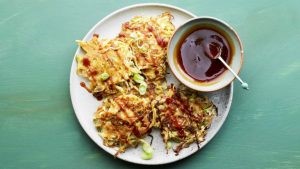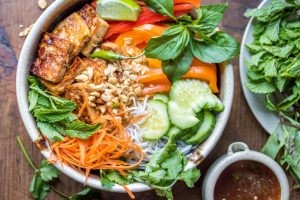Favourite international cuisine
Thank you to our readers for participating in our competition last month and submitting their favourite international cuisine recipes. Here are a few of the recipes that were submitted.
Japanese Okonomiyaki
Okonomiyaki are traditional Japanese fritter-like pancakes that are great for using up a head of white cabbage. Serve with okonomiyaki sauce, Japanese mayonnaise or your favourite hot sauce. We got several recipes for these, this is one of them.

Okonomiyaki sauce
1½ tbsp tomato ketchup
½ tbsp Worcestershire sauce
2 tsp runny honey
1 tsp dark soy sauce
Okonomiyaki pancakes
3 large free-range eggs
3 tbsp plain flour
½ tsp sea salt
½ tsp dark soy sauce
½ tsp toasted sesame oil
2 large spring onions, thinly sliced
275g white cabbage, shredded
Sunflower oil.
For the okonomiyaki sauce, whisk together all sauce ingredients in a small bowl until combined. Set aside.
To make the okonomiyaki batter, whisk together the eggs, flour, salt, soy sauce and toasted sesame oil until smooth.
Fold the spring onions and cabbage into the batter until everything is well coated.
Heat enough oil to just cover the bottom of a large frying pan over a medium–high heat until shimmering. Line a warmed plate with a couple of sheets of kitchen paper.
Spoon some of the cabbage mixture into the pan into pancake shapes that are about the size of your palm. Press down with the back of the spoon and fry until golden-brown on each side, flipping halfway. Transfer the pancakes to the kitchen paper to drain.
Fry in batches until you have run out of mixture – you should get about eight pancakes.
Serve the pancakes drizzled with the okonomiyaki sauce.
Thüringer Rostbratwurst
Thüringer Rostbratwurst is German pork and veal sausage from Thuringia with rich tradition. The first documented reference dates back to 1404. The oldest known recipe can be found in the Weimar State Archives. This isn’t something that everyone can make at home, as you may not have the facilities, however they could maybe be made into patties to be able to try them??


Meat
750g pork shoulder, jowls
250g veal
Spices per 1000g (1 kg) of meat
18g / 3 tsp salt
2.0g / 1 tsp white pepper
2.0g / 1 tsp caraway, whole seed
0.5g / 1/4 tsp mace
2.0g / 1 tsp marjoram, rubbed
0.5g / 1/4 tsp caraway, ground
0.5g / 1/4 tsp cardamom
3.0g / 1 clove garlic, smashed.
Grind veal with a 1/8” plate. Grind again or emulsify in food processor adding a little milk or water.
Grind pork adding salt through 10 mm (3/8”) plate.
Mix/knead pork with spices until sticky. Add emulsified veal and mix again.
Stuff loosely into 28 mm hog or sheep casings twisting into 20cm links. Then refrigerate.
Cook by frying or grilling, served on a bread roll with a good German mustard.
Each Thüringer Rostbratwurst sausage is 15-20cm long and weighs 100 -150g.
Bún chay
The Vietnamese dish bun chay (bún chay, pronounced “boon chai”) is a noodle salad made with rice vermicelli noodles (bun), which are served with lots of vegetables and fresh herbs. There are many variations to this Vietnamese noodle bowl, however they usually include rice noodles topped with meat or fried tofu, bean sprouts, lots of herbs, shallots, crispy onions, chilli, and crunchy chopped peanuts and maybe pickled vegetables, with a dressing of lime juice and fish sauce. This is eaten all over Vietnam. Here is a Tofu version:


Dressing
1/4 cup rice vinegar
3 tbsp lime juice
3 tbsp coconut or date sugar
2 tbsp mushroom soy sauce – or low-sodium soy sauce
2 tbsp freshly grated lemongrass – white part only
1 clove garlic – grated
1 to 2 bird’s eye chilies – sliced (optional)
2 to 3 dashes Maggi seasoning
1 tbsp water
Bún chay
8 ounces thin rice noodles – vermicelli-style
2 carrots – julienned
1 large bell pepper – orange, yellow, or red, thinly sliced
1 cup English cucumber half-moons
1 cup cilantro stems and leaves – remove tough stem ends if desired
1 cup Thai basil leaves
1 cup mint leaves
1 cup chopped peanuts
Lime wedges for serving – optional
Caramelized tofu
1 tbsp peanut oil
400g firm tofu – sliced into bite-sized rectangles
2 tsp mushroom soy sauce – or low sodium soy-sauce
1 tbsp sesame oil
1 tbsp coconut or date sugar.
Set a large pot of water on the stove to boil for cooking the noodles.
While the water is heating, whisk the dressing ingredients together in a small bowl. Set aside to infuse.
After the water has boiled, cook the noodles according to package directions; rinse with cold water, drain well, then divide into four serving bowls.
Heat one tablespoon of peanut oil in a large skillet set over medium heat. Add the tofu pieces and fry until golden brown, about 5 to 7 minutes on both sides. While the tofu is frying, stir the mushroom soy sauce, sesame oil, and sugar together in a small bowl until the sugar has dissolved.
Once the tofu has browned, pour this mixture into the pan. Allow the sauce to cook in the pan for 1 to 2 minutes, until it begins to thicken. Flip the tofu to ensure the sauce coats and sticks to each side. Cook for another minute or so, until the tofu is caramelized and sticky. Transfer the tofu to the noodle bowls.
Top the noodle bowls with julienned carrot, sliced bell pepper, cucumber half-moons, herbs, and peanuts. Pour a quarter of the prepared dressing over each bowl. Serve straight away.
Want more of our recipes? Check out our recipe hub. Click here for the recipe hub.
Recipe and image source:
Easy okonomiyaki recipe – BBC Food
www.meatsandsausages.com/sausage-recipes/fresh/german/thuringer-rostbratwurst
thewanderlustkitchen.com/vegan-bun-chay-vietnamese-noodle-salad/






